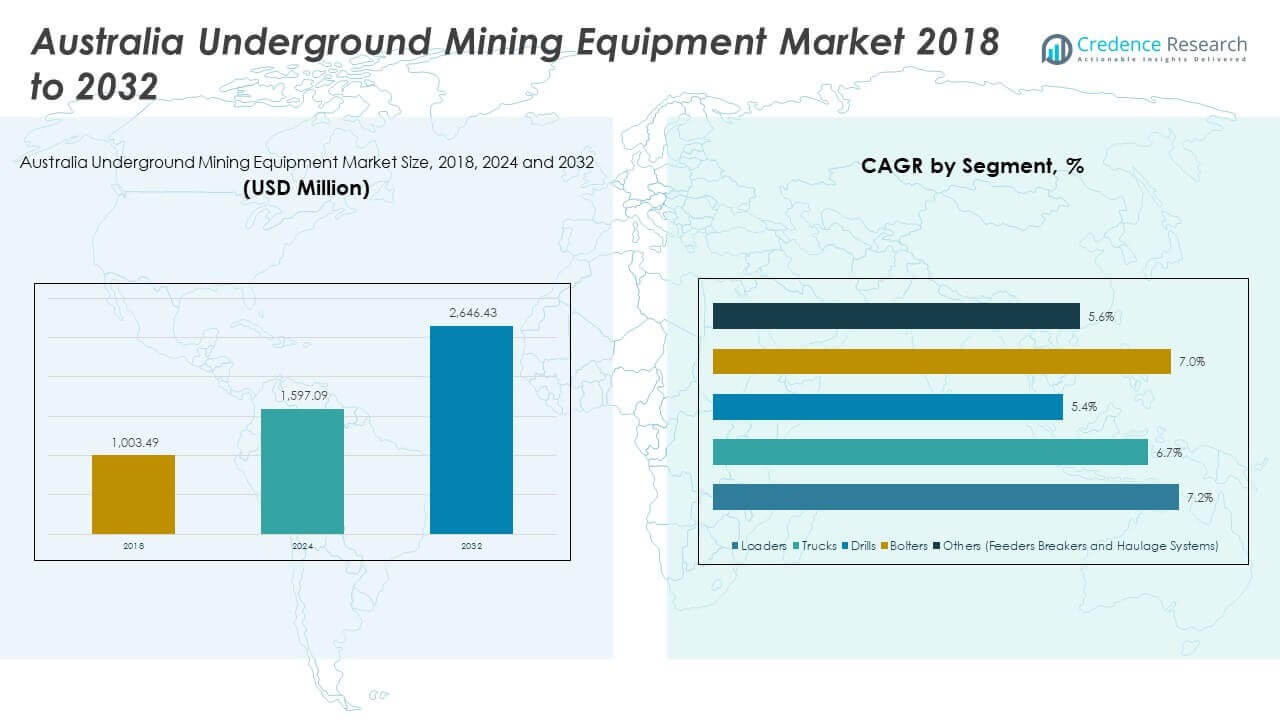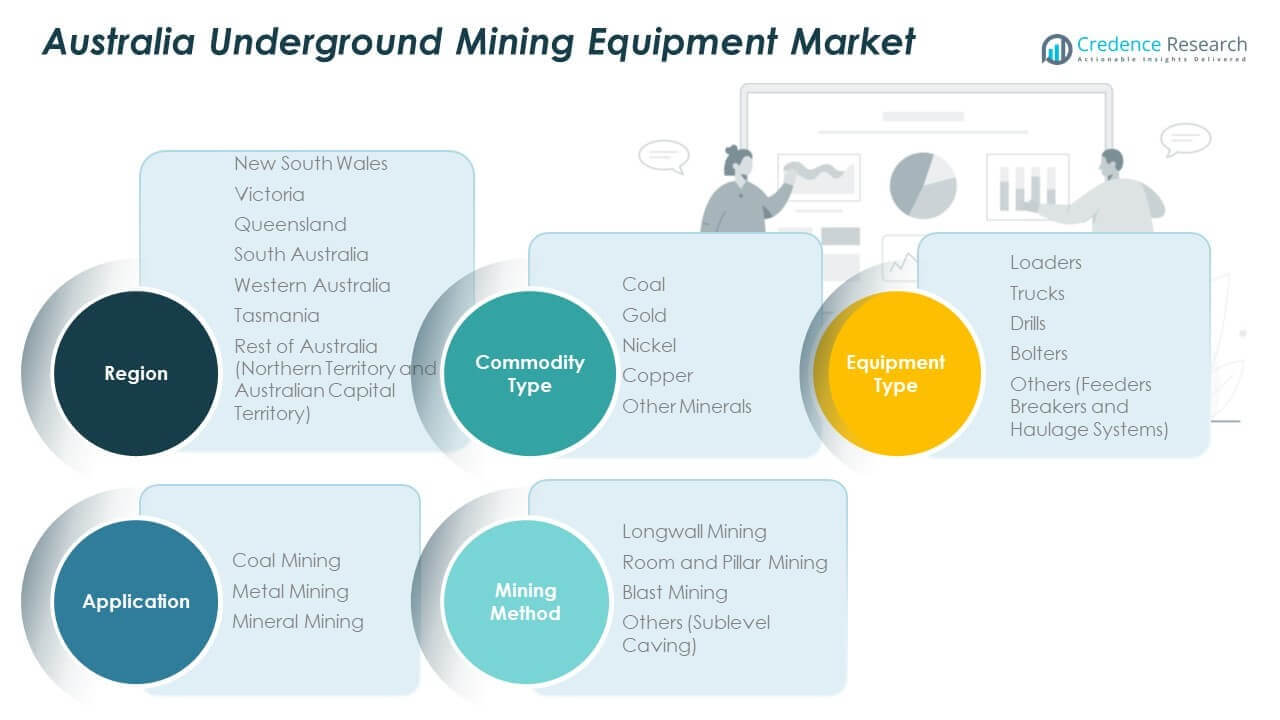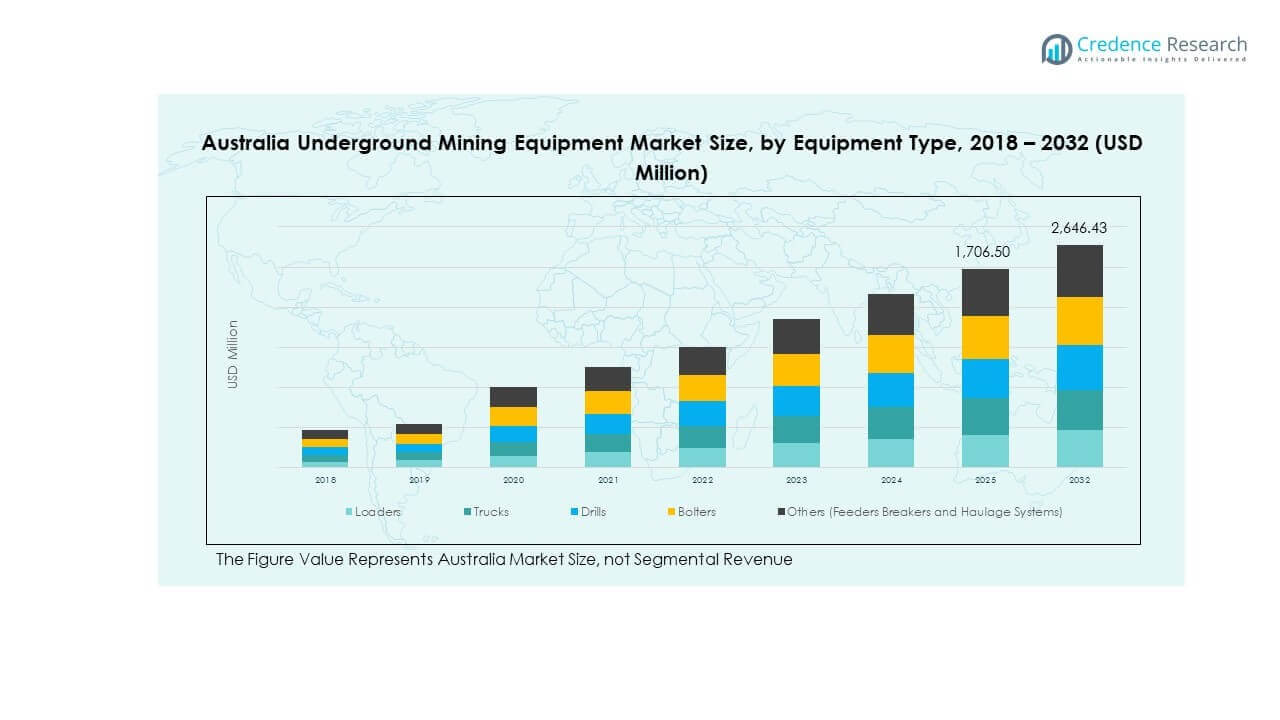Market Overview:
The Australia Underground Mining Equipment Market size was valued at USD 1,003.49 million in 2018 to USD 1,597.09 million in 2024 and is anticipated to reach USD 2,646.43 million by 2032, at a CAGR of 6.47% during the forecast period.
| REPORT ATTRIBUTE |
DETAILS |
| Historical Period |
2020-2023 |
| Base Year |
2024 |
| Forecast Period |
2025-2032 |
| Australia Underground Mining Equipment Market Size 2024 |
USD 1,597.09 Million |
| Australia Underground Mining Equipment Market, CAGR |
6.47% |
| Australia Underground Mining Equipment Market Size 2032 |
USD 2,646.43 Million |
The market is driven by increasing demand for advanced mining machinery, stricter safety standards, and rising mineral exploration projects across the country. Automation and electrification are gaining traction as mining companies focus on cost efficiency and sustainability. Strong government support for expanding underground mining operations also encourages investment in next-generation equipment. In addition, heightened demand for resources such as coal, gold, and copper supports consistent adoption of modern underground machinery, further accelerating market expansion.
Regionally, Western Australia dominates the underground mining equipment market due to its vast mineral reserves and well-established mining infrastructure. Queensland is emerging as another key growth hub, driven by its coal production and new exploration projects. Other regions, including New South Wales and Northern Territory, are witnessing steady growth as mining companies expand operations in response to resource demand. The combination of established mining clusters and new exploration activities ensures a balanced growth pattern across Australia.
Market Insights
- The Australia Underground Mining Equipment Market was valued at USD 1,003.49 million in 2018, reached USD 1,597.09 million in 2024, and is projected at USD 2,646.43 million by 2032, growing at a CAGR of 6.47%.
- Western Australia (42%), Queensland (28%), and New South Wales (16%) dominate due to their extensive mineral reserves, export-oriented operations, and established mining infrastructure.
- South Australia (7%) emerges as the fastest-growing region, driven by strong investments in copper and nickel exploration projects.
- By equipment type, loaders hold 32% of the 2024 share, reflecting their critical role in ore handling and transport in underground operations.
- Trucks account for 27% in 2024, underscoring their importance in supporting efficient haulage systems for large-scale projects.
Access crucial information at unmatched prices!
Request your sample report today & start making informed decisions powered by Credence Research Inc.!
Download Sample
Market Drivers
Rising Demand for Advanced and Automated Equipment to Enhance Efficiency and Safety
The mining sector in Australia is under pressure to maximize output while ensuring worker safety. This drives the adoption of advanced underground equipment with automated features. Companies are investing in systems that reduce downtime and increase operational accuracy. Digital monitoring solutions are also helping identify faults before they escalate. The Australia Underground Mining Equipment Market benefits from these technology-driven shifts. Stronger safety standards from regulators further push companies toward smarter machinery. Operators see improved productivity and reduced risks when adopting automation. It continues to fuel consistent investment in high-performance solutions.
Growing Focus on Electrification of Mining Machinery to Support Sustainability Goals
Mining operators are steadily shifting toward electric-powered underground equipment. This transition lowers operating costs and reduces greenhouse gas emissions. Companies recognize the long-term savings gained through reduced fuel dependency. Equipment manufacturers are expanding their electric product portfolios to match operator demand. The Australia Underground Mining Equipment Market reflects this move toward sustainable operations. It encourages miners to upgrade fleets with advanced electric loaders and haulers. Governments highlight decarbonization targets, making electrification more attractive. The momentum supports a greener, more competitive mining industry.
- For instance, Alkane Resources deployed four Cat R2900 XE diesel-electric underground loaders at its Tomingley mine in New South Wales in 2024, achieving nearly 30% fleet-wide fuel consumption reduction. This deployment significantly lowered underground ventilation requirements and reduced overall site carbon footprint, as confirmed by both Alkane’s technical management and Caterpillar partners.
Expanding Mineral Exploration Activities Driving Equipment Deployment Across New Projects
Increased exploration projects across gold, copper, and coal deposits generate consistent demand for underground equipment. New discoveries across Western Australia and Queensland lead to significant investments in machinery. Miners require reliable drills, loaders, and haulage systems to expand operations. The Australia Underground Mining Equipment Market thrives as exploration widens its scope. It supports equipment suppliers with steady revenue streams from long-term projects. Rising global commodity demand encourages companies to boost exploration budgets. Contractors rely on efficient machines to deliver consistent output in tough conditions. The expansion cycle continues to stimulate the market.
- For instance, in 2024, Liebherr-Australia began delivering a major order of 17 new excavators—including ten R9600s and five R9400s—across six Glencore mining sites in Queensland and New South Wales. By mid-2025, two R9600s had reached Hail Creek in Queensland and two units (including a R9400) were delivered to the Ravensworth complex in New South Wales, marking first-time deliveries at these key expansion sites.
Government Policies Supporting Infrastructure and Mining Sector Investments
Policy frameworks from Australian authorities support domestic mining growth. Subsidies and incentives promote adoption of advanced machinery across underground sites. Regulations encourage operators to replace outdated systems with safer and efficient equipment. Infrastructure projects create demand for mined commodities, indirectly boosting equipment usage. The Australia Underground Mining Equipment Market gains traction through strong government backing. It motivates companies to expand operational capacity with modernized fleets. Safety-focused rules align with investments in training and machinery upgrades. This combination of policy and industry alignment strengthens the market outlook.

Market Trends
Integration of Digital Technologies for Remote Operations and Predictive Maintenance
Digitalization is a defining trend reshaping mining processes across Australia. Companies integrate IoT and AI tools to enable predictive maintenance. This helps operators minimize costly breakdowns and improve asset utilization. Remote operations supported by advanced connectivity reduce worker exposure underground. The Australia Underground Mining Equipment Market evolves rapidly with digital transformation. It drives reliance on data-driven decision-making to optimize output. Companies deploy software platforms that support real-time tracking of machine performance. It marks a shift toward smart, connected mining ecosystems.
- For instance, in August 2025, WEG deployed IoT-based WEGsmart® sensors at a high-volume copper mine in Western Australia, successfully detecting abnormal vibration in a 12 MW SAG mill motor; this enabled targeted maintenance and prevented unplanned downtime, with operators remotely monitoring real-time data via the WEG Motion Fleet Management platform.
Adoption of Sustainable Practices Through Recycling and Circular Economy Models
Sustainability has become a key priority in mining operations. Firms introduce recycling initiatives for equipment parts and materials. This supports a circular economy within the underground equipment sector. The Australia Underground Mining Equipment Market sees rising demand for eco-friendly practices. Companies refurbish components to extend lifecycle and cut costs. Equipment makers also design machines with higher recyclability standards. Mining operators align with environmental goals while reducing capital expenditure. The trend enhances resource efficiency and market credibility.
Shift Toward Customized Equipment Solutions Designed for Local Mine Conditions
Mining operations vary by ore type, depth, and regional geology. This drives demand for customized underground equipment tailored to unique conditions. Manufacturers develop machinery suited for Australian mines with rugged terrains. The Australia Underground Mining Equipment Market grows with rising customization needs. It helps miners achieve optimal performance in demanding environments. Tailored solutions improve efficiency and extend machinery lifespan. Companies prioritize suppliers offering flexible product modifications. This trend continues to strengthen supplier-operator partnerships.
- For instance, Direct Mining has supplied remote-controlled underground ventilation doors and developed pneumatic chute loading systems, customized and in operation for over 12 years at a leading Australian copper and gold mine, with these solutions now operated remotely from surface control rooms to improve air quality and operational safety.
Increasing Collaboration Between Equipment Manufacturers and Mining Companies
Partnerships between miners and equipment producers expand innovation pipelines. Collaborative projects drive co-development of specialized machinery. This approach ensures equipment meets exact operational needs. The Australia Underground Mining Equipment Market benefits from such alliances. It fosters joint testing of prototypes in real mining conditions. Partnerships also shorten timelines for bringing innovations to market. Companies gain competitive advantage through shared expertise. The trend highlights cooperative models shaping future mining practices.
Market Challenges Analysis
High Capital Investment Requirements Creating Financial Barriers for Miners
Underground mining equipment requires significant upfront investment. Many smaller operators struggle to finance large-scale machinery purchases. Leasing models are limited, leaving fewer options for budget-constrained miners. The Australia Underground Mining Equipment Market faces slower adoption among smaller players. It highlights the gap between established companies and mid-tier firms. High costs also delay replacement of aging fleets across several sites. Financial constraints weaken overall market growth potential. It underscores the importance of flexible financing mechanisms.
Operational Challenges Linked to Harsh Mining Conditions and Equipment Maintenance
Mining operations in Australia face extreme underground environments. Harsh conditions accelerate wear and tear on machinery components. This leads to frequent maintenance requirements and higher operating costs. The Australia Underground Mining Equipment Market adapts by emphasizing durable designs. Equipment downtime still disrupts production schedules and impacts profitability. Lack of skilled maintenance staff adds complexity to operations. Smaller firms face difficulty sustaining equipment performance standards. These challenges underline the sector’s vulnerability to operational risks.
Market Opportunities
Rising Demand for Electric and Hybrid Equipment Creating New Growth Prospects
The shift toward electric and hybrid machines opens major opportunities for suppliers. Companies aim to reduce emissions and cut fuel costs simultaneously. The Australia Underground Mining Equipment Market leverages this change to accelerate innovation. It drives manufacturers to introduce advanced loaders and trucks powered by clean energy. Electric fleets also align with global investors prioritizing ESG-friendly portfolios. Operators benefit from enhanced performance and compliance with sustainability goals. It positions Australia as a leader in green mining adoption. Suppliers with early offerings stand to capture strong market share.
Expansion of Exploration Projects and Technology Integration Fueling Long-Term Growth
Ongoing exploration of gold, copper, and coal reserves sustains equipment demand. Technology integration within machinery further strengthens growth prospects. The Australia Underground Mining Equipment Market reflects this alignment of exploration and innovation. Operators increasingly adopt smart systems with real-time monitoring features. This dual approach drives efficiency while maximizing resource extraction. Remote control capabilities also reduce risks associated with underground operations. Growing exploration budgets provide consistent revenue streams for suppliers. It sets the stage for sustained long-term opportunities in the sector.

Market Segmentation Analysis
By commodity type, coal dominates the Australia Underground Mining Equipment Market due to the country’s extensive coal reserves and strong export demand. Gold and copper follow as significant contributors, supported by sustained exploration and investment projects. Nickel shows steady adoption with rising interest in battery production, while other minerals create niche demand that broadens equipment utilization.
- For instance, in August 2025, Glencore announced the deployment of 17 Liebherr mining excavators—including 10 R 9600 (600-tonne class) and 5 R 9400 (345-tonne class)—across six major coal sites in Queensland and New South Wales, strengthening large-scale coal equipment utilization in Australia’s underground export sector.
By equipment type, loaders and trucks represent the largest share owing to their critical role in underground transport and handling. Drills maintain consistent demand with ongoing exploration and development activities. Bolters gain importance with safety standards emphasizing roof support systems. Other equipment, including feeders, breakers, and haulage systems, strengthens operational continuity across varied mining sites.
By application, coal mining remains the leading segment, reflecting its dominance in national energy exports. Metal mining, including gold, copper, and nickel, is expanding with rising global demand. Mineral mining creates additional opportunities, particularly in specialized operations targeting diverse resources. The Australia Underground Mining Equipment Market benefits from the balance between traditional coal reliance and diversification into metals.
- For instance, Whitehaven Coal’s Narrabri underground mine reported ROM (run-of-mine) coal production of 657,000 tonnes for the March 2024 quarter, with output reflecting significant underground equipment deployment in Australia’s leading coal segment.
By mining method, longwall mining holds the largest share due to its efficiency in large-scale coal production. Room and pillar mining maintains presence in regions with geological suitability. Blast mining is applied in operations requiring controlled fragmentation. Other methods such as sublevel caving expand usage in deeper deposits, ensuring broader adoption of underground equipment across mining practices.

Segmentation
By Commodity Type
- Coal
- Gold
- Nickel
- Copper
- Other Minerals
By Equipment Type
- Loaders
- Trucks
- Drills
- Bolters
- Others (Feeders, Breakers, and Haulage Systems)
By Application
- Coal Mining
- Metal Mining
- Mineral Mining
By Mining Method
- Longwall Mining
- Room and Pillar Mining
- Blast Mining
- Others (Sublevel Caving)
By Region
- New South Wales
- Victoria
- Queensland
- South Australia
- Western Australia
- Tasmania
- Rest of Australia (Northern Territory and Australian Capital Territory)
Regional Analysis
Western Australia leads the Australia Underground Mining Equipment Market with a market share of 42%. The region’s dominance is supported by extensive reserves of iron ore, gold, and nickel. Mining companies invest heavily in advanced underground equipment to maintain production efficiency. The established infrastructure and concentration of large multinational mining firms create steady demand for loaders, drills, and haulage systems. Western Australia also benefits from strong export-focused operations, further driving equipment adoption. It remains the key hub for technological upgrades in underground mining machinery.
Queensland holds a market share of 28%, supported by its strong coal mining sector and growing metal exploration. The state emphasizes expanding underground projects to strengthen export capacity. Queensland miners increasingly adopt electric and automated systems to meet sustainability targets. Its focus on safety compliance also boosts demand for modern bolters and continuous miners. The combination of coal dominance and growing diversification strengthens Queensland’s role in the market. It continues to attract international equipment suppliers seeking long-term contracts.
New South Wales contributes 16%, followed by South Australia with 7%, Victoria with 4%, and Tasmania with 2%. New South Wales sees steady adoption driven by coal and copper mining activities. South Australia records rising investment in copper and nickel exploration, encouraging equipment deployment. Victoria’s smaller mining base keeps demand modest, though metal mining sustains equipment needs. Tasmania focuses on mineral mining, keeping underground machinery requirements steady. The Rest of Australia, including Northern Territory and ACT, collectively accounts for 1%, supported by scattered exploration projects. It underscores the concentration of mining strength within the top regions.
Shape Your Report to Specific Countries or Regions & Enjoy 30% Off!
Key Player Analysis
- Epiroc AB
- Caterpillar Inc.
- Sandvik AB
- Komatsu Limited
- GEARS Mining
- Jacon Equipment
- Eickhoff Bergbautechnik GmbH – Eickhoff Australia Pty Ltd
- MacLean Engineering & Marketing Co. Limited
- PPK Mining Equipment Pty Ltd
Competitive Analysis
The Australia Underground Mining Equipment Market is highly consolidated, with global leaders and regional manufacturers competing across product categories. Caterpillar, Sandvik, Epiroc, and Komatsu dominate through extensive portfolios of loaders, trucks, and drills. Their strong distribution networks and aftersales service strengthen long-term relationships with mining operators. Regional players such as GEARS Mining, Jacon Equipment, and PPK Mining Equipment enhance competitiveness by focusing on specialized solutions tailored for Australian mine conditions. It allows them to capture niche segments where flexibility and customization are crucial. The competitive landscape is shaped by innovation in electrification, automation, and safety-focused machinery. Global leaders invest in digital solutions, predictive maintenance systems, and hybrid equipment, ensuring they remain aligned with evolving industry standards. Regional companies differentiate themselves with service-based offerings and cost-effective equipment. The combination of international dominance and local expertise creates a balanced market structure.
Recent Developments
- In July 2025, Meeka Metals began ramping up underground mining activities at its Murchison gold project in Western Australia, marking the start of scheduled ore extraction from underground at the Andy Well site as part of a wider production ramp-up.
- In August 2025, Liebherr-Australia and Glencore finalized a significant new partnership involving a 17-machine delivery plan across six major mining operations, signifying a major equipment rollout that strengthens both companies’ presence in the underground mining sector.
- In July 2025, Sandvik and Glencore expanded their partnership to include Newtrax’s OEM-agnostic proximity detection and collision avoidance technology, aiming to advance operational safety and efficiency for Glencore’s underground mixed equipment fleet in Australia and globally.
Report Coverage
The research report offers an in-depth analysis based on Commodity Type, Equipment Type, Application and Mining Method. It details leading market players, providing an overview of their business, product offerings, investments, revenue streams, and key applications. Additionally, the report includes insights into the competitive environment, SWOT analysis, current market trends, as well as the primary drivers and constraints. Furthermore, it discusses various factors that have driven market expansion in recent years. The report also explores market dynamics, regulatory scenarios, and technological advancements that are shaping the industry. It assesses the impact of external factors and global economic changes on market growth. Lastly, it provides strategic recommendations for new entrants and established companies to navigate the complexities of the market.
Future Outlook
- Automation will remain a central growth driver, with mining companies investing in intelligent drilling and hauling equipment to boost productivity.
- Electrification of underground machinery will accelerate as operators pursue reduced emissions and lower fuel costs.
- Advanced safety systems will gain traction, with bolters and monitoring technologies ensuring compliance with stricter workplace standards.
- Demand for loaders and trucks will expand steadily, driven by deeper mining operations and complex ore bodies.
- Western Australia will continue to dominate the market, supported by large-scale investments in mineral exploration.
- Queensland will strengthen its position with coal mining projects and new developments in metallurgical resources.
- Rising exploration of copper, gold, and nickel will create sustained demand for versatile and durable equipment.
- Regional manufacturers will gain importance by offering customized and cost-effective machinery suited to local mining conditions.
- Partnerships between miners and global equipment suppliers will foster innovation in hybrid and digitally connected systems.
- The Australia Underground Mining Equipment Market will evolve toward sustainable, technology-driven practices, shaping long-term industry competitiveness.










